2018考研英语翻译真题每日一句拆分解读(Day18)_毙考题
2018考研英语翻译小技巧-毙考题
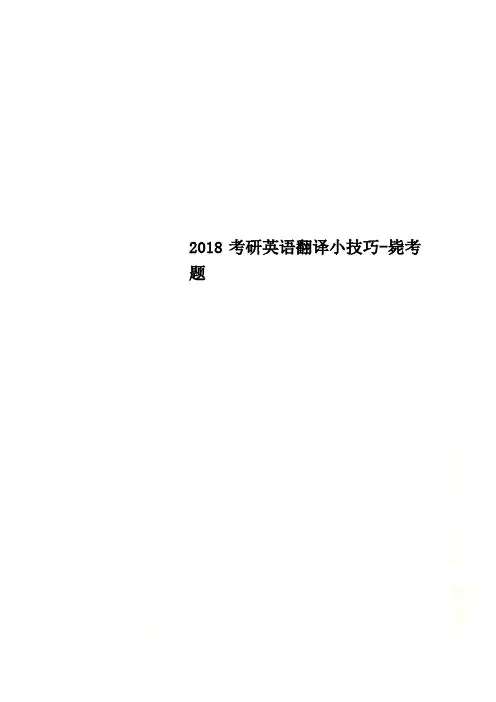
2018考研英语翻译小技巧-毙考题2018考研英语翻译小技巧 摘要:随着考研英语对长难句考察的侧重,近年来的翻译题中也出现了越来越多的长难句,让考生感到无从下手。
以下是一些翻译小技巧,帮助大家攻克英语翻译。
翻译过程中包括两个阶段:正确理解和充分表达。
理解是表达的前提,而表达是理解的目的和结果,二者缺一不可,因此,考生在做英译汉部分试题时:1、切记不可急躁,一定要先通读全句,把握主旨、内容;2、首先要在语义上理清全句的整体意思和每个单词的意思;其次要分析清楚句子结构,理出句群,找出各分句之间的关系;3、可考虑先打一份翻译草稿,再根据文章意义和汉语结构进行调整。
英语中一词多义的现象十分普遍,且英汉词典中给出的汉语解释未必全面,未必与英文的意思完全对等。
选择词义的时候,要根据词在句中的词类及上下文的搭配关系来确定。
英译汉中常考短语和句型:1、not that but that 不是而是2、can not too 再也不过分3、other than 除了,不同于4、It is reported / asserted / believed / considered / said /supposed that 据报道/据宣称/据说/据假设5、nothing less than 完全是,不亚于6、anything but 根本不,绝不7、nothing but 只有,不过......而已8、all but 除了9、but for 如果没有10、but that+从句要不是11、only to+动词结果是,不料12、not so much as 与其说不如说13、not so much as 甚至不14、not nearly/far from 不近/远15、by no means (同义短语还有:in no way,in no case, in no respects, at no time, on no account, under no circumstance) 决不16、to say nothing of/ still less(常用于否定句后) 更不必说17、let alone 更不用提18、no more than 同一样不19、no more than 只只,仅是考试使用毙考题,不用再报培训班邀请码:880620、more than21、more than 超出22、no less than 多达;足足有之多23、no less than 没有比更少;至少与一样考试使用毙考题,不用再报培训班邀请码:880624、apart from 分离25、no choice but 别无选择,只有考试使用毙考题,不用再报培训班邀请码:8806。
2018考研英语翻译每日一句:秦始皇_毙考题
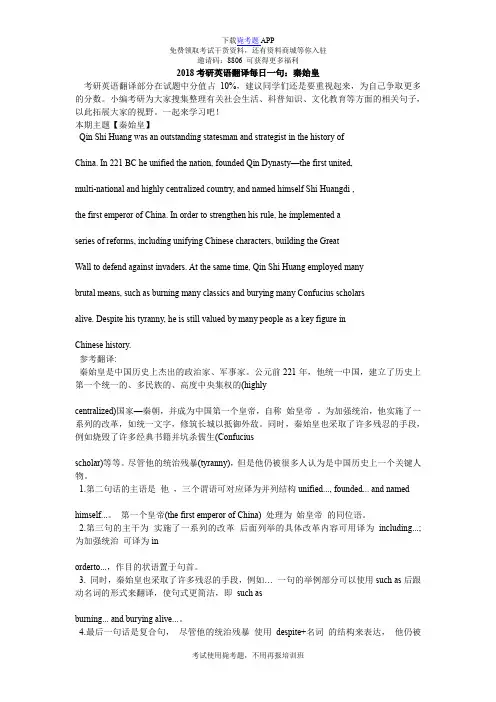
2018考研英语翻译每日一句:秦始皇考研英语翻译部分在试题中分值占10%,建议同学们还是要重视起来,为自己争取更多的分数。
小编考研为大家搜集整理有关社会生活、科普知识、文化教育等方面的相关句子,以此拓展大家的视野。
一起来学习吧!本期主题【秦始皇】Qin Shi Huang was an outstanding statesman and strategist in the history ofChina. In 221 BC he unified the nation, founded Qin Dynasty—the first united,multi-national and highly centralized country, and named himself Shi Huangdi ,the first emperor of China. In order to strengthen his rule, he implemented aseries of reforms, including unifying Chinese characters, building the GreatWall to defend against invaders. At the same time, Qin Shi Huang employed manybrutal means, such as burning many classics and burying many Confucius scholarsalive. Despite his tyranny, he is still valued by many people as a key figure inChinese history.参考翻译:秦始皇是中国历史上杰出的政治家、军事家。
公元前221年,他统一中国,建立了历史上第一个统一的、多民族的、高度中央集权的(highlycentralized)国家—秦朝,并成为中国第一个皇帝,自称始皇帝。
2018考研英语真题之长难句翻译及解析3(共5则)
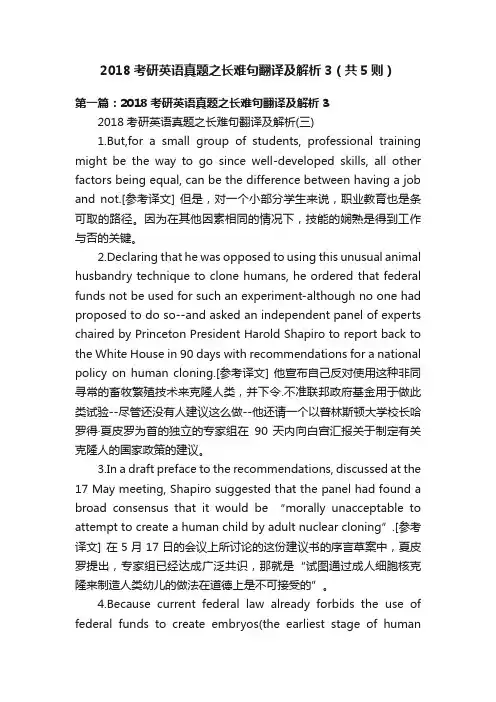
2018考研英语真题之长难句翻译及解析3(共5则)第一篇:2018考研英语真题之长难句翻译及解析32018考研英语真题之长难句翻译及解析(三)1.But,for a small group of students, professional training might be the way to go since well-developed skills, all other factors being equal, can be the difference between having a job and not.[参考译文] 但是,对一个小部分学生来说,职业教育也是条可取的路径。
因为在其他因素相同的情况下,技能的娴熟是得到工作与否的关键。
2.Declaring that he was opposed to using this unusual animal husbandry technique to clone humans, he ordered that federal funds not be used for such an experiment-although no one had proposed to do so--and asked an independent panel of experts chaired by Princeton President Harold Shapiro to report back to the White House in 90 days with recommendations for a national policy on human cloning.[参考译文] 他宣布自己反对使用这种非同寻常的畜牧繁殖技术来克隆人类,并下令.不准联邦政府基金用于做此类试验--尽管还没有人建议这么做--他还请一个以普林斯顿大学校长哈罗得·夏皮罗为首的独立的专家组在90 天内向白宫汇报关于制定有关克隆人的国家政策的建议。
2018年考研英语翻译真题解析
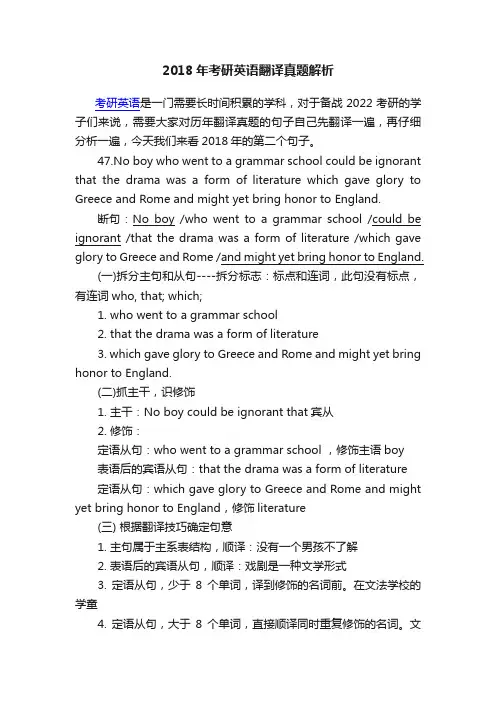
2018年考研英语翻译真题解析考研英语是一门需要长时间积累的学科,对于备战2022考研的学子们来说,需要大家对历年翻译真题的句子自己先翻译一遍,再仔细分析一遍,今天我们来看2018年的第二个句子。
47.No boy who went to a grammar school could be ignorant that the drama was a form of literature which gave glory to Greece and Rome and might yet bring honor to England.断句:No boy /who went to a grammar school /could be ignorant /that the drama was a form of literature /which gave glory to Greece and Rome /and might yet bring honor to England.(一)拆分主句和从句----拆分标志:标点和连词,此句没有标点,有连词who, that; which;1. who went to a grammar school2. that the drama was a form of literature3. which gave glory to Greece and Rome and might yet bring honor to England.(二)抓主干,识修饰1. 主干:No boy could be ignorant that宾从2. 修饰:定语从句:who went to a grammar school ,修饰主语boy表语后的宾语从句:that the drama was a form of literature定语从句:which gave glory to Greece and Rome and might yet bring honor to England,修饰literature(三) 根据翻译技巧确定句意1. 主句属于主系表结构,顺译:没有一个男孩不了解2. 表语后的宾语从句,顺译:戏剧是一种文学形式3. 定语从句,少于8个单词,译到修饰的名词前。
2018考研英语翻译真题每日一句拆分解读(Day16)_毙考题
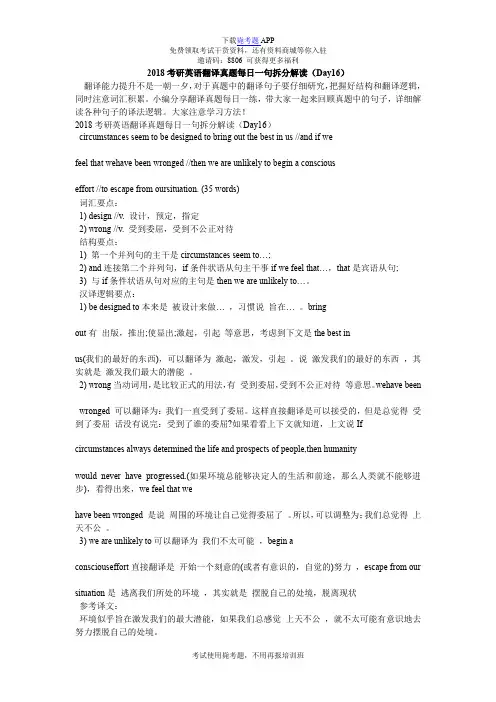
2018考研英语翻译真题每日一句拆分解读(Day16)翻译能力提升不是一朝一夕,对于真题中的翻译句子要仔细研究,把握好结构和翻译逻辑,同时注意词汇积累。
小编分享翻译真题每日一练,带大家一起来回顾真题中的句子,详细解读各种句子的译法逻辑。
大家注意学习方法!2018考研英语翻译真题每日一句拆分解读(Day16)circumstances seem to be designed to bring out the best in us //and if wefeel that wehave been wronged //then we are unlikely to begin a consciouseffort //to escape from oursituation. (35 words)词汇要点:1) design //v. 设计,预定,指定2) wrong //v. 受到委屈,受到不公正对待结构要点:1) 第一个并列句的主干是circumstances seem to…;2) and连接第二个并列句,if条件状语从句主干事if we fee l that…,that是宾语从句;3) 与if条件状语从句对应的主句是then we are unlikely to…。
汉译逻辑要点:1) be designed to本来是被设计来做… ,习惯说旨在… 。
bringout有出版,推出;使显出;激起,引起等意思,考虑到下文是the best inus(我们的最好的东西),可以翻译为激起,激发,引起。
说激发我们的最好的东西,其实就是激发我们最大的潜能。
2) wrong当动词用,是比较正式的用法,有受到委屈,受到不公正对待等意思。
wehave beenwronged 可以翻译为:我们一直受到了委屈。
这样直接翻译是可以接受的,但是总觉得受到了委屈话没有说完:受到了谁的委屈?如果看看上下文就知道,上文说Ifcircumstances always determined the life and prospects of people,then humanitywould never have progressed.(如果环境总能够决定人的生活和前途,那么人类就不能够进步),看得出来,we feel that wehave been wronged 是说周围的环境让自己觉得委屈了。
2018考研英语:常见长难句解析(18)_毙考题
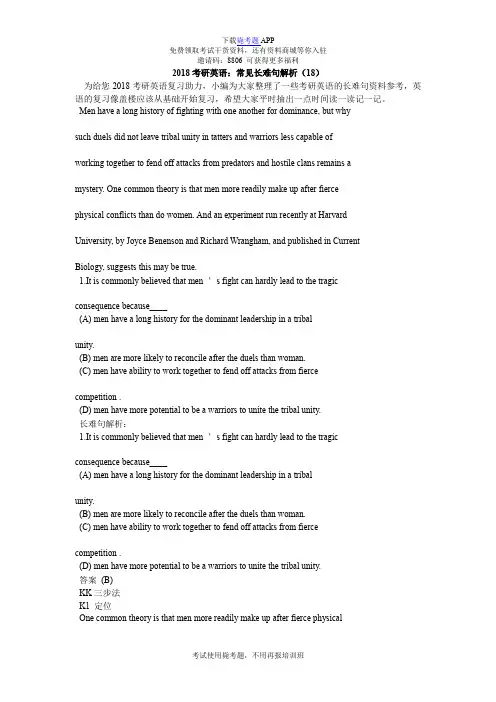
2018考研英语:常见长难句解析(18)为给您2018考研英语复习助力,小编为大家整理了一些考研英语的长难句资料参考,英语的复习像盖楼应该从基础开始复习,希望大家平时抽出一点时间读一读记一记。
Men have a long history of fighting with one another for dominance, but whysuch duels did not leave tribal unity in tatters and warriors less capable ofworking together to fend off attacks from predators and hostile clans remains amystery. One common theory is that men more readily make up after fiercephysical conflicts than do women. And an experiment run recently at HarvardUniversity, by Joyce Benenson and Richard Wrangham, and published in CurrentBiology, suggests this may be true.1.It is commonly believed that men ’s fight can hardly lead to the tragicconsequence because____(A) men have a long history for the dominant leadership in a tribalunity.(B) men are more likely to reconcile after the duels than woman.(C) men have ability to work together to fend off attacks from fiercecompetition .(D) men have more potential to be a warriors to unite the tribal unity.长难句解析:1.It is commonly believed that men ’s fight can hardly lead to the tragicconsequence because____(A) men have a long history for the dominant leadership in a tribalunity.(B) men are more likely to reconcile after the duels than woman.(C) men have ability to work together to fend off attacks from fiercecompetition .(D) men have more potential to be a warriors to unite the tribal unity.答案(B)KK三步法K1 定位One common theory is that men more readily make up after fierce physicalconflicts than do women.题干中的commonly 就可以帮助我们找到这句话!而且前一句就是题干中的结果!leave tribal unity in tatters and warriors less capable of workingtogether=题干中的tragic consequence;好好看一下上一句的结构!Why…is a mystery.下一句就解释原因!这样可以直接排除A和C,这属于典型的定位错误!K2 替换B选项中的reconcile=make up 和解,妥协;fierce physical conflicts=duel格斗;K3 排除实话说第四个选项就是我在机舱里写这个题的时候胡编的一个选项,到现在我都不知道是什么意思。
2018考研英语翻译每日一句:百度_毙考题
下载毙考题APP免费领取考试干货资料,还有资料商城等你入驻邀请码:8806 可获得更多福利2018考研英语翻译每日一句:百度考研英语翻译部分在试题中分值占10%,建议同学们还是要重视起来,为自己争取更多的分数。
小编考研为大家搜集整理有关社会生活、科普知识、文化教育等方面的相关句子,以此拓展大家的视野。
一起来学习吧!本期主题【百度】Baidu is the world s largest Chinese search engine.The company was founded by Robin Li and Xu Yongin Beijing s Zhongguancun in January 2000,devoted to providing a simple and reliable way inobtaining information for the public. After years ofdevelopment, thousands of research and development engineers work in Baidu and they holdthe most advanced technology of search engine in the world. Baidu has become one of theChinese high-tech enterprises that master the most sophisticated core technology. Easilyoperated, all the products of Baidu concern every aspect of common people s work and life, so ithas become the most popular and influential Chinese website in China.参考翻译:百度(Baidu)是全球最大的中文搜索引擎。
18年考研英语真题及解析
2018年全国硕士研究生入学统一考试英语(一) Section I Use of EnglishDirections:Read the following text. Choose the best word (s) for each numbered blank and mark A, B, C or D on the ANSWER SHEET. (10 points)Trust is a tricky business. On the one hand, it's a necessary condition 1 many worthwhile things: child care, friendships, etc. On the other hand, putting your 2 , in the wrong place often carries a high 3 .4 , why do we trust at all? Well, because it feels good.5 people place their trust in an individual or an institution, their brains release oxytocin, a hormone that6 pleasurable feelings and triggers the herding instruct that prompts humans to7 with one another. Scientists have found that exposure8 this hormone puts us in a trusting9: In a Swiss study, researchers sprayed oxytocin into the noses of half the subjects; those subjects were ready to lend significantly higher amounts of money to strangers than were their 10 who inhaled something else.11 for us, we also have a sixth sense for dishonesty that may 12 us. A Canadian study found that children as young as 14 months can differentiate 13 a credible person and a dishonest one. Sixty toddlers were each 14 to an adult tester holding a plastic container. The tester would ask, “What’s in here?” before look ing into the container, smiling, and exclaiming, “Wow!” Each subject was then invited to look 15 . Half of them found a toy; the other half 16 the container was empty-and realized the tester had 17 them.Among the children who had not been tricked, the majority were 18 to cooperate with the tester in learning a new skill, demonstrating that they trusted his leadership.19 , only five of the 30 children paired with the “20”tester participated in a follow-up activity.1. [A] on [B] like [C] for [D] from2. [A] faith [B] concern [C] attention [D] interest3. [A] benefit [B] debt [C] hope [D] price4. [A] Therefore [B] Then [C] Instead [D] Again5. [A]Until [B] Unless [C] Although [D] When6. [A] selects [B] produces [C] applies [D] maintains7. [A] consult [B] compete [C] connect [D] compare8. [A] at [B] by [C]of [D]to9. [A] context [B] mood [C] period [D] circle10.[A] counterparts [B] substitutes [C] colleagues [D]supporters11.[A] Funny [B] Lucky [C] Odd [D] Ironic12.[A] monitor [B] protect [C] surprise [D] delight13.[A] between [B] within [C] toward [D] over14.[A] transferred [B] added [C] introduced [D] entrusted15.[A] out [B] back [C] around [D] inside16.[A] discovered [B] proved [C] insisted [D] .remembered17.[A] betrayed [B]wronged [C] fooled [D] mocked18.[A] forced [B] willing [C] hesitant [D] entitled19.[A] In contrast [B] As a result [C] On the whole [D] For instance20.[A] inflexible [B] incapable [C] unreliable [D] unsuitableSection II Reading ComprehensionPart ADirections:Read the following four texts. Answer the questions below each text by choosing A, B, C or D. Mark your answers on the ANSWER SHEET. (40 points)Text 1Among the annoying challenges facing the middle class is one that will probably go unmentioned in the next presidential campaign: What happens when the robots come for their jobs?Don't dismiss that possibility entirely. About half of U.S. jobs are at high risk of being automated, according to a University of Oxford study, with the middle class disproportionately squeezed. Lower-income jobs like gardening or day care don't appeal to robots. But many middle-class occupations-trucking, financial advice, software engineering — have aroused their interest, or soon will. The rich own the robots, so they will be fine.This isn't to be alarmist. Optimists point out that technological upheaval has benefited workers in the past. The Industrial Revolution didn't go so well for Luddites whose jobs were displaced by mechanized looms, but it eventually raised living standards and created more jobs than it destroyed. Likewise, automation should eventually boost productivity, stimulate demand by driving down prices, and free workers from hard, boring work. But in the medium term, middle-class workers may need a lot of help adjusting.The first step, as Erik Brynjolfsson and Andrew McAfee argue in The Second Machine Age, should be rethinking education and job training. Curriculums —from grammar school to college- should evolve to focus less on memorizing facts and more on creativity and complex communication. Vocational schools should do a better job of fostering problem-solving skills and helping students work alongside robots. Online education can supplement the traditional kind. It could make extra training and instruction affordable. Professionals trying to acquire new skills will be able to do so without going into debt.The challenge of coping with automation underlines the need for the U.S. to revive its fading business dynamism: Starting new companies must be made easier. In previous eras of drastic technological change, entrepreneurs smoothed the transition by dreaming up ways to combine labor and machines. The best uses of 3D printers and virtual reality haven't been invented yet. The U.S. needs the new companies that will invent them.Finally, because automation threatens to widen the gap between capital income and labor income, taxes and the safety net will have to be rethought. Taxes onlow-wage labor need to be cut, and wage subsidies such as the earned income tax credit should be expanded: This would boost incomes, encourage work, reward companies for job creation, and reduce inequality.Technology will improve society in ways big and small over the next few years, yet this will be little comfort to those who find their lives and careers upended by automation. Destroying the machines that are coming for our jobs would be nuts. But policies to help workers adapt will be indispensable.21.Who will be most threatened by automation?[A] Leading politicians.[B]Low-wage laborers.[C]Robot owners.[D]Middle-class workers.22 .Which of the following best represent the author’s view?[A] Worries about automation are in fact groundless.[B]Optimists' opinions on new tech find little support.[C]Issues arising from automation need to be tackled[D]Negative consequences of new tech can be avoidedcation in the age of automation should put more emphasis on[A] creative potential.[B]job-hunting skills.[C]individual needs.[D]cooperative spirit.24.The author suggests that tax policies be aimed at[A] encouraging the development of automation.[B]increasing the return on capital investment.[C]easing the hostility between rich and poor.[D]preventing the income gap from widening.25.In this text, the author presents a problem with[A] opposing views on it.[B]possible solutions to it.[C]its alarming impacts.[D]its major variations.Text 2A new survey by Harvard University finds more than two-thirds of young Americans disapprove of President Trump’s use of Twitter. The implication is that Millennials prefer news from the White House to be filtered through other source, Not a president’s social media platform.Most Americans rely on social media to check daily headlines. Yet as distrust has risen toward all media, people may be starting to beef up their media literacy skills. Such a trend is badly needed. During the 2016 presidential campaign, nearly a quarter of web content shared by Twitter users in the politically critical state of Michigan was fake news, according to the University of Oxford. And a survey conducted for BuzzFeed News found 44 percent of Facebook users rarely or never trust news from the media giant.Young people who are digital natives are indeed becoming more skillful at separating fact from fiction in cyberspace. A Knight Foundation focus-group survey of young people between ages 14and24 found they use “distributed trust” to verifystories. They cross-check sources and prefer news from different perspectives—especially those that are open about any bias. “Many young people assume a great deal of personal responsibility for educating themselves and actively seeking out opposing viewpoints,” the survey concluded.Such active research can have another effect. A 2014 survey conducted in Australia, Britain, and the United States by the University of Wisconsin-Madison found that young people’s reliance on social media led to greater political engagement.Social media allows users to experience news events more intimately and immediately while also permitting them to re-share news as a projection of their values and interests. This forces users to be more conscious of their role in passing along information. A survey by Barna research group found the top reason given by Americans for the fake news phenomenon is “reader error,” more so than made-up stories or factual mistakes in reporting. About a third say the problem of fake news lies in “misinterpretation or exaggeration of actual news” via social media. In other words, the choice to share news on social media may be the heart of the issue. “This indicates there is a real personal responsibility in counteracting this problem,” says Roxanne Stone, editor in chief at Barna Group.So when young people are critical of an over-tweeting president, they reveal a mental discipline in thinking skills – and in their choices on when to share on social media.26. According to the Paragraphs 1 and 2, many young Americans cast doubts on[A] the justification of the news-filtering practice.[B] people’s preference for social media platforms.[C] the administrations ability to handle information.[D] social media was a reliable source of news.27. The phrase “beer up”(Line 2, Para. 2) is closest in meaning to[A] sharpen[B] define[C] boast[D] share28. According to the knight foundation survey, young people[A] tend to voice their opinions in cyberspace.[B] verify news by referring to diverse resources.[C] have s strong sense of responsibility.[D] like to exchange views on “distributed trust”29. The Barna survey found that a main cause for the fake news problem is[A] readers outdated values.[B] journalists’ biased reporting[C] readers’ misin terpretation[D] journalists’ made-up stories.30. Which of the following would be the best title for the text?[A] A Rise in Critical Skills for Sharing News Online[B] A Counteraction Against the Over-tweeting Trend[C] The Accumulation of Mutual Trust on Social Media.[D] The Platforms for Projection of Personal Interests.Text 3Any fair-minded assessment of the dangers of the deal between Britain's National Health Service (NHS) and DeepMind must start by acknowledging that both sides mean well. DeepMind is one of the leading artificial intelligence (AI) companies in the world. The potential of this work applied to healthcare is very great, but it could also lead to further concentration of power in the tech giants. It Is against that background that the information commissioner, Elizabeth Denham, has issued her damning verdict against the Royal Free hospital trust under the NHS, which handed over to DeepMind the records of 1.6 million patients In 2015 on the basis of a vague agreement which took far too little account of the patients' rights and their expectations of privacy.DeepMind has almost apologized. The NHS trust has mended its ways. Further arrangements- and there may be many-between the NHS and DeepMind will be carefully scrutinised to ensure that all necessary permissions have been asked of patients and all unnecessary data has been cleaned. There are lessons about informed patient consent to learn. But privacy is not the only angle in this case and not even the most important. Ms Denham chose to concentrate the blame on the NHS trust, since under existing law it “controlled” the data and DeepMind merely “processed" it. But this distinction misses the point that it is processing and aggregation, not the mere possession of bits, that gives the data value.The great question is who should benefit from the analysis of all the data that our lives now generate. Privacy law builds on the concept of damage to an individual from identifiable knowledge about them. That misses the way the surveillance economy works. The data of an individual there gains its value only when it is compared with the data of countless millions more.The use of privacy law to curb the tech giants in this instance feels slightly maladapted. This practice does not address the real worry. It is not enough to say that the algorithms DeepMind develops will benefit patients and save lives. What matters is that they will belong to a private monopoly which developed them using public resources. If software promises to save lives on the scale that dugs now can, big data may be expected to behave as a big pharm has done. We are still at the beginning of this revolution and small choices now may turn out to have gigantic consequences later. A long struggle will be needed to avoid a future of digital feudalism. Ms Denham's report is a welcome start.31.Wha is true of the agreement between the NHS and DeepMind ?[A] It caused conflicts among tech giants.[B] It failed to pay due attention to patient’s rights.[C] It fell short of the latter's expectations[D] It put both sides into a dangerous situation.32. The NHS trust responded to Denham's verdict with[A] empty promises.[B] tough resistance.[C] necessary adjustments.[D] sincere apologies.33.The author argues in Paragraph 2 that[A] privacy protection must be secured at all costs.[B] leaking patients' data is worse than selling it.[C] making profits from patients' data is illegal.[D] the value of data comes from the processing of it34.According to the last paragraph, the real worry arising from this deal is[A] the vicious rivalry among big pharmas.[B] the ineffective enforcement of privacy law.[C] the uncontrolled use of new software.[D] the monopoly of big data by tech giants.35.The author's attitude toward the application of AI to healthcare is[A] ambiguous.[B] cautious.[C] appreciative.[D] contemptuous.Text 4The U.S. Postal Service (USPS) continues to bleed red ink. It reported a net loss of $5.6 billion for fiscal 2016, the 10th straight year its expenses have exceeded revenue. Meanwhile, it has more than $120 billion in unfunded liabilities, mostly for employee health and retirement costs. There are many bankruptcies. Fundamentally, the USPS is in a historic squeeze between technological change that has permanently decreased demand for its bread-and-butter product, first-class mail, and a regulatory structure that denies management the flexibility to adjust its operations to the new realityAnd interest groups ranging from postal unions to greeting-card makers exert self-interested pressure on the USPS’s ultimate overseer-Congress-insisting that whatever else happens to the Postal Service, aspects of the status quo they depend on get protected. This is why repeated attempts at reform legislation have failed in recent years, leaving the Postal Service unable to pay its bills except by deferring vital modernization.Now comes word that everyone involved---Democrats, Republicans, the Postal Service, the unions and the system's heaviest users—has finally agreed on a plan to fix the system. Legislation is moving through the House that would save USPS an estimated $28.6 billion over five years, which could help pay for new vehicles, among other survival measures. Most of the money would come from a penny-per-letter permanent rate increase and from shifting postal retirees into Medicare. The latter step would largely offset the financial burden of annually pre-funding retiree health care, thus addressing a long-standing complaint by the USPS and its union.If it clears the House, this measure would still have to get through the Senate –where someone is bound to point out that it amounts to the bare, bare minimum necessary to keep the Postal Service afloat, not comprehensive reform. There’s no change to collective bargaining at the USPS, a major omission considering thatpersonnel accounts for 80 percent of the agency’s costs. Also missing is any discussion of eliminating Saturday letter delivery. That common-sense change enjoys wide public support and would save the USPS $2 billion per year. But postal special-interest groups seem to have killed it, at least in the House. The emerging consensus around the bill is a sign that legislators are getting frightened about a politically embarrassing short-term collapse at the USPS. It is not, however, a sign that they’re getting serious about transforming the postal system for the 21st century.36.The financial problem with the USPS is caused partly by[A]. its unbalanced budget.[B] .its rigid management.[C] .the cost for technical upgrading.[D]. the withdrawal of bank support.37. According to Paragraph 2, the USPS fails to modernize itself due to[A]. the interference from interest groups.[B] .the inadequate funding from Congress.[C] .the shrinking demand for postal service.[D] .the incompetence of postal unions.38.The long-standing complaint by the USPS and its unions can be addressed by[A] .removing its burden of retiree health care.[B] .making more investment in new vehicles.[C] .adopting a new rate-increase mechanism.[D]. attracting more first-class mail users.39.In the last paragraph, the author seems to view legislators with[A] respect.[B] tolerance.[C] discontent.[D] gratitude.40.Which of the following would be the best title for the text?[A] .The USPS Starts to Miss Its Good Old Days[B] .The Postal Service: Keep Away from My Cheese[C] .The USPS: Chronic Illness Requires a Quick Cure[D] .The Postal Service Needs More than a Band-AidPart BDirections:The following paragraphs are given in a wrong order. For Questions 41-45, you are required to reorganize these paragraphs into a coherent article by choosing from the list A-G and filling them into the numbered boxes. Paragraphs C and F have been correctly placed. Mark your answers on ANSWER SHEET. (10 points)A. In December of 1869, Congress appointed a commission to select a site and prepare plans and cost estimates for a new State Department Building. The commission was also to consider possible arrangements for the War and Navy Departments. To the horror of some who expected a Greek Revival twin of the Treasury Building to be erected on the other side of the White House, the elaborateFrench Second Empire style design by Alfred Mullett was selected, and construction of a building to house all three departments began in June of 1871.B. Completed in 1875, the State Department's south wing was the first to be occupied, with its elegant four-story library (completed in 1876), Diplomatic Reception Room, and Secretary's office decorated with carved wood, Oriental rugs, and stenciled wall patterns. The Navy Department moved into the east wing in 1879, where elaborate wall and ceiling stenciling and marquetry floors decorated the office of the Secretary.C. The State, War, and Navy Building, as it was originally known, housed the three Executive Branch Departments most intimately associated with formulating and conducting the nation's foreign policy in the last quarter of the nineteenth century and the first quarter of the twentieth century-the period when the United States emerged as an international power. The building has housed some of the nation's most significant diplomats and politicians and has been the scene of many historic events.D. Many of the most celebrated national figures have participated in historical events that have taken place within the EEOB's granite walls. Theodore and Franklin D. Roosevelt, William Howard Taft, Dwight D. Eisenhower, Lyndon B. Johnson, Gerald Ford, and George H. W. Bush all had offices in this building before becoming president. It has housed 16 Secretaries of the Navy, 21 Secretaries of War, and 24 Secretaries of State. Winston Churchill once walked its corridors and Japanese emissaries met here with Secretary of State Cordell Hull after the bombing of Pearl Harbor.E. The Eisenhower Executive Office Building (EEOB) commands a unique position in both the national history and the architectural heritage of the United States. Designed by Supervising Architect of the Treasury, Alfred B. Mullett, it was built from 1871 to 1888 to house the growing staffs of the State, War, and Navy Departments, and is considered one of the best examples of French Second Empire architecture in the country.F. Construction took 17 years as the building slowly rose wing by wing. When the EEOB was finished, it was the largest office building in Washington, with nearly 2 miles of black and white tiled corridors. Almost all of the interior detail is of cast iron or plaster; the use of wood was minimized to insure fire safety. Eight monumental curving staircases of granite with over 4,000 individually cast bronze balusters are capped by four skylight domes and two stained glass rotundas.G. The history of the EEOB began long before its foundations were laid. The first executive offices were constructed between 1799 and 1820. A series of fires (including those set by the British in 1814) and overcrowded conditions led to the construction of the existing Treasury Building. In 1866, the construction of the North Wing of the Treasury Building necessitated the demolition of the State Department building.41.—C—42.—43.—F—44.—45.Part CDirections:Read the following text carefully and then translate the underlined segments into Chinese. Your translation should be written neatly on the ANSWER SHEET. (10 points)Shakespeare’s life time was coincident with a period of extraordinary activity and achievement in the drama. (6)By the date of his birth Europe was witnessing the passing of the religious drama, and the creation of new forms under the incentive of classical tragedy and comedy. These new forms were at first mainly written by scholars and performed by amateurs, but in England, as everywhere else in western Europe, the growth of a class of professional actors was threatening to make the drama popular, whether it should be new or old, classical or medieval, literary or farcical. Court, school organizations of amateurs, and the traveling actors were all rivals in supplying a widespread desire for dramatic entertainment; and (47) no boy who went a grammar school could be ignorant that the drama was a form of literature which gave glory to Greece and Rome and might yet bring honor to England.When Shakespeare was twelve years old, the first public playhouse was built in London. For a time literature showed no interest in this public stage. Plays aiming at literary distinction were written for school or court, or for the choir boys of St. Paul’s and the royal chapel, who, however, gave plays in public as well as at court.(48)but the professional companies prospered in their permanent theaters, and university men with literature ambitions were quick to turn to these theaters as offering a means of livelihood. By the time Shakespeare was twenty-five, Lyly, Peele, and Greene had made comedies that were at once popular and literary; Kyd had written a tragedy that crowded the pit; and Marlowe had brought poetry and genius to triumph on the common stage - where they had played no part since the death of Euripides. (49)A native literary drama had been created, its alliance with the public playhouses established, and at least some of its great traditions had been begun.The development of the Elizabethan drama for the next twenty-five years is of exceptional interest to students of literary history, for in this brief period we may trace the beginning, growth, blossoming, and decay of many kinds of plays, and of many great careers. We are amazed today at the mere number of plays produced, as well as by the number of dramatists writing at the same time for this London of two hundred thousand inhabitants. (50) To realize how great was the dramatic activity, we must remember further that hosts of plays have been lost, and that probably there is no author of note whose entire work has survived.Section III WritingPart A51. Directions:Write an email to all international experts on campus inviting them to attend the graduation ceremony. In your email you should include time, place and other relevant information about the ceremony.You should write about 100 words neatly on the ANSEWER SHEETDo not use your own name at the end of the email. Use “Li Ming” instead. (10 points)Part B52. Directions:Write an essay of 160-200 words based on the picture below. In your essay, you should2018年全国硕士研究生入学统一考试英语答案解析1.[答案]C[解析]该题选择的是介词,与后面的many worthwhile things一块做后置定语修饰前面的condition,表明对于许多重要事情来说是一个必要的条件。
2018考研英语翻译真题每日一句拆分解读(Day24)_毙考题
2018考研英语翻译真题每日一句拆分解读(Day24)翻译能力提升不是一朝一夕,对于真题中的翻译句子要仔细研究,把握好结构和翻译逻辑,同时注意词汇积累。
小编分享翻译真题每日一练,带大家一起来回顾真题中的句子,详细解读各种句子的译法逻辑。
大家注意学习方法!2018考研英语翻译真题每日一句拆分解读(Day24)It tends to ignore, //and thus eventually to eliminate, //many elements inthe landcommunity that lack commercial value, //but that are essential to itshealthy functioning.(27 words)词汇要点:1) eliminate //v. 排除,消除,根除;淘汰2) element //n. 基本部分,因素,要素结构要点:1) 主句是It tends to ignore, and... to eliminate...;2) many elements作to ignore, and...toeliminate这两个动词宾语;3) many elements...that…,but that…是but并列的两个that定语从句汉译逻辑要点:1) It tends to ignore中代词it在整个句子的主语部分,最好指代明确。
看上文To sum up: a system ofconservation based solely on economic self-interest is hopelesslylopsided.(总之,一个仅仅建立在利己基础上的保护体系是非常不平衡的)就知道,it应该指的是上文的这种观点,或者这种保护体系。
可以翻译为这种保护体系往往会忽视… 。
2) many elements in the landcommunity可以直接翻译为:土地群落中的很多因素。
2018考研英语长难句解析:每日一句(2)_毙考题
下载毙考题APP免费领取考试干货资料,还有资料商城等你入驻邀请码:8806 可获得更多福利2018考研英语长难句解析:每日一句(2)2008年真题Section ⅠUse of English 第3段第1句This group generally do well in IQ test, scoring 12-15 points above themean value of 100, and have contributed disproportionately to the intellectualand cultural life of the West, as the careers of their elites, including severalworld-renowned scientists, affirm.译文:这个群体通常在智商测试中表现出色,得分比平均值100分高出12到15分,并且他们对西方的知识和文化领域做出了与人口比例不相称的贡献,他们中的精英——包括几位世界知名的科学家——的事业证明了这一点。
分析:本句的主干为:This group (主语)+ do well(谓语1)+and(连词)+have contributed…to(谓语2)+the intellectual and culturallife(宾语),等于是并列连词and连接了两个并列的分句。
第一个分句中,现在分词结构scoring…100是伴随状语,描述了与前面同时发生的动作。
第二个分句中包含了一个由as 引导的定语从句,修饰句子Thisgroup…have contributed disproportionately to the intellectual and cultural lifeof the West。
词汇指南do[du:](v.)做,干(中考词汇)(笔者认为,do-做、干由to-去一词变化而来[t-d清浊]→ 去做、去干——即做、干。
- 1、下载文档前请自行甄别文档内容的完整性,平台不提供额外的编辑、内容补充、找答案等附加服务。
- 2、"仅部分预览"的文档,不可在线预览部分如存在完整性等问题,可反馈申请退款(可完整预览的文档不适用该条件!)。
- 3、如文档侵犯您的权益,请联系客服反馈,我们会尽快为您处理(人工客服工作时间:9:00-18:30)。
下载毙考题APP
免费领取考试干货资料,还有资料商城等你入驻
邀请码:8806 可获得更多福利
2018考研英语翻译真题每日一句拆分解读(Day18)
翻译能力提升不是一朝一夕,对于真题中的翻译句子要仔细研究,把握好结构和翻译逻辑,同时注意词汇积累。
小编分享翻译真题每日一练,带大家一起来回顾真题中的句子,详细解读各种句子的译法逻辑。
大家注意学习方法!
2018考研英语翻译真题每日一句拆分解读(Day18)
while we may be able to sustain the illusion of control through the
conscious mind alone, in reality we are continually faced with a question: Why
cannot I make myself do this or achieve that?
词汇要点:
1) sustain //v. 支撑,维持,保持
2) illusion //n. 幻想,错觉,假象
3) conscious //adj. 感觉到的,意识到的,清醒的;自觉地,有意识的
结构要点:
1) while…是让步状语从句;
2) 主句是we are…faced with…。
汉译逻辑要点:
1) the illusion of
control可以直接翻译为控制的错觉,但控制总觉得是动词,汉语话没有说完一样。
需要返回原文看看,指代的是上文control our
thoughts ,翻译的时候需要补充完整能控制自己思想的错觉。
2) conscious是有意识的,mind 心理、思维活动。
through the conscious mind
alone,翻译为仅仅靠有意识的思维活动,它修饰动词sustain。
完整译文:
我们或许仅仅靠有意识的思维活动就可以维持这种能控制自己思想的错觉,但事实上我们却不断碰到一个问题:为什么我不能让自己去做这件事情,实现那个目标呢?
考试使用毙考题,不用再报培训班。
